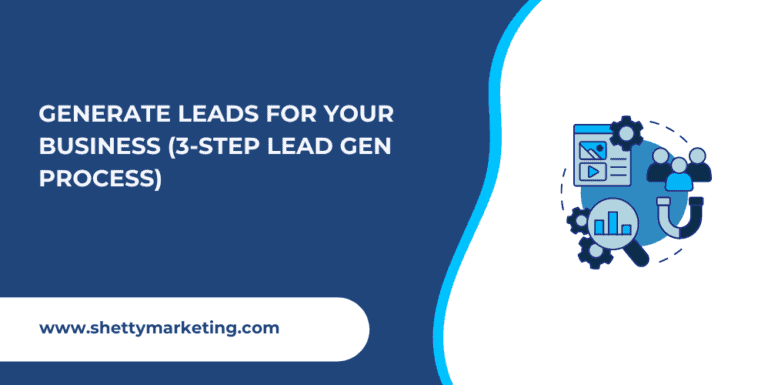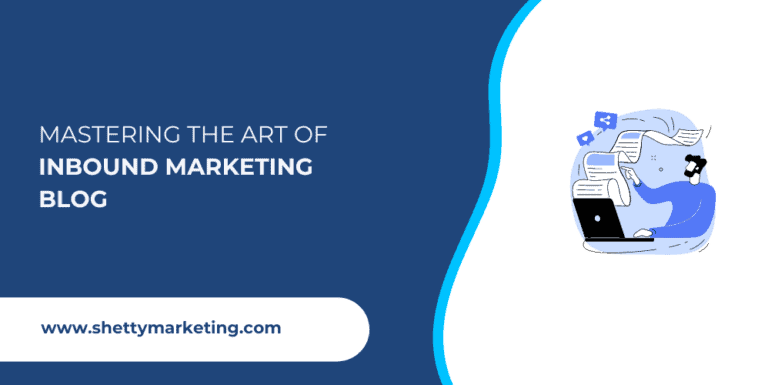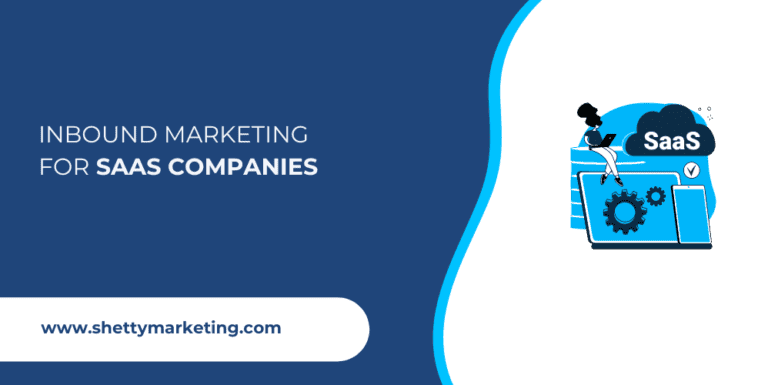Today, leads are generated via lead magnets. A lead magnet is something valuable you offer to your prospect in exchange for their contact information.
It can be an ebook, whitepaper, or something sophisticated such as a ROI calculator.
It’s a simple concept of reciprocity
You can then nurture your list of contacts by providing them with content that addresses their business challenges and subtly highlights how your product or service can help resolve those issues.
When the time is right, you can pitch your product or service.
But how do you when it’s time?
To know that, you need to understand the process of lead generation.
Lead generation works in three stages:
- Getting the attention of your target audience
- Qualifying leads through lead scoring
- Closing the deal with the qualified leads
Now, let’s delve into the specifics of each stage.
Stage 1: Getting the attention of your potential customer
This step involves identifying the right type of person or company who would be interested in purchasing your product/service.
In order to achieve this, you need to understand your customer base thoroughly.
For example, let us say you run a website design company. Your target market consists of business owners who are looking to build high-quality websites.
So, to connect with these businesses, you gotta grab their attention.
To achieve this, you can engage with social platforms like LinkedIn or Facebook and share posts or content that would appeal to business owners. Many B2B marketers, like myself, have found success in sharing use cases or case studies.
In the post above, Fery talks about his case study on link building to attract the interest of business owners who want to enhance their website’s SEO.
Though this isn’t exactly lead generation, it does establish him as an authority in that field, which will help him obtain high conversions if he pushes a lead magnet.
In this scenario, an ideal lead magnet would be “Go through 10 similar link-building case studies in my latest e-book”. He can then add a link to a landing page with the lead magnet.
Stage 2: Qualifying leads through lead scoring
As a B2B marketer, my goal is to generate leads. However, it’s my duty to make sure that most of those leads are of good quality.
It’s hard to make out whether most of the leads are potential buyers or not.
The best way of finding that out is using lead scoring.
Lead scoring is a marketing process that allows companies to qualify leads based on the level of interest they show in their product or service. It is a way to filter out low buyer intent leads and helps you focus on more qualified ones.
So, most B2B digital marketers run lead-generation campaigns on social media sites, blogs, email lists, and so on to generate huge volumes of leads. Bear in mind that at this stage, marketers usually provide low-ticket offers such as an ebook or a whitepaper.
Related : B2B marketing plans (Solid framework + Marketing strategies)
These leads will be then nurtured using high-quality lead magnets such as free trials, one-on-one free consultation calls, etc.
The nurturing can be done via remarketing on social media platforms, google search or display ads, and email automation. The ones who show interest in the content will be given a certain lead score.
Every time the user interacts with the company’s valuable content, the score keeps adding to their profile. Once the ideal customer profile is qualified to be a high-quality lead, the company will try to approach the potential lead with its offerings.
I’ll be explaining lead scoring in detail in the upcoming sections.
Stage 3: Closing the deal with the qualified leads
You can use several methods to convince your prospect including but not limited to:
Offering free trials
Offering a free trial is one of the most effective ways to convert leads into paying customers. Free trials allow your website visitors to try your product or service before they buy it.
This gives them the opportunity to see if they like it and also helps them understand what they are getting into.
Remember, this is a high-ticket offer you are providing to a potential prospect. You wouldn’t want to waste your time on irrelevant and low buyer-intent prospects.
Giving away samples
Giving away samples is a great way to convert leads. It has many benefits, such as being able to leverage the power of social proof and increase customer engagement. This method also allows you to build a relationship with your customers and get them hooked on your product.
The best way to use this technique is by giving away something that is related to your product, but not too expensive.
For example, if you are selling beauty products, you can give away a sample of moisturizer or eye cream.
Providing special discounts
Some companies offer discounts as a way to convert leads into customers. The idea is that the customer will not have any reason to go with a competitor if they are offered a discount.
Companies can use discounts in different ways. They can offer them for certain periods of time, or they can give them for certain items, or they can give discounts in exchange for people sharing their opinion about the product on social media.
Creating a sense of urgency
A sense of urgency is created in many ways. One way is to show a deadline for the offer. Another way is to show the scarcity of the offer.
Some companies use urgency as a tactic to convert leads into customers. For example, they will say that there are only 10 more hours left to take advantage of this offer and it will expire soon.
This tactic can be used when people are on the fence about buying something or making a decision.
What is the best way to generate leads (Bets lead generation strategies)
Search engine optimization
Search engine optimization is the process of optimizing your website content so that it ranks highly on search engines.
It is a great way to attract a steady stream of prospective customers. It is not complicated, there are so many guides online that can help you learn SEO. However, it would be much easier to hire an SEO company to save you time.
Related : How to find a good SEO expert ( and how to avoid bad ones)
B2B marketers create many SEO-optimized blogs which are informational to the users. They add relevant lead magnets as a pop-up for the potential leads to download. Every business I know has been following this strategy for ages and it has been working out really well for them.
Cold email campaigns
Cold email marketing allows marketers to generate leads without spending a lot of money on advertising. It is a cost-effective way of generating leads and at the same time, it helps in building a database of contacts.
The best way to do it is by buying an email list from brokers and promoting lead magnets to them via cold email campaigns. Just promote valuable content to them and convert them to warm leads. Then you can monitor the contacts using lead scoring.
Related : How to Get Business Emails for Marketing: 3 Ways to Grow your Email List
The success of cold email marketing depends on the tone and style of the message. If you are too pushy or aggressive, then your target audience will not be interested in reading your message.
The best way to write an effective cold email is by using a conversational tone and asking for permission before you ask for anything else.
Paid advertising
Even though paid advertising is an expensive way to generate leads, it helps businesses get the word out about their products and services. It’s one of the most effective ways to generate leads for your company.
Related : How can I Advertise my Business on Google for free in 2024
I personally use LinkedIn and Facebook to run lead-generation ads. They have something called native lead-gen forms which can be used to reduce the friction points for potential clients. The users don’t have to enter their email addresses, it is automatically filled thanks to LinkedIn
Press release
A press release is an official announcement of a newsworthy event, product, or service. They are written in a formal tone and are typically sent to journalists for publication.
Press releases can be used for lead generation purposes. By providing valuable information about the company to the public, they can generate leads from people who want to know more about the company or purchase their products or services.
Guest posts
Guest blogging is one of the most efficient ways to get high-quality traffic, leads, and links to your website. You can share a long-form blog post on one of these guest posts and promote contextual lead magnets here. The major advantage here is that the website is already attracting tons of traffic, so you don’t have to worry about SEO.
Different types of Lead magnets that you can offer in 2024
A lead magnet is a free offer that you give to your potential customers in exchange for their contact information. This can be a powerful tool to generate many leads. However, your prospects will only take the free offer if it is valuable enough.
Below I’ll list some of the lead magnets you use for lead generation.
Free Ebooks or Whitepaper
Ebooks are a great way to generate leads for your business. They can be used to educate your target audience about how you can help them, or they can be used as lead magnets in a blog post.
For example, if you want to build an email list of affiliate marketers to promote your affiliate marketing course, you can create an ebook with 150+ profitable niches.
Though this may require a significant amount of your time, it is a valuable resource for your target market. They wouldn’t think twice about accepting the offer. Remember that the more time and effort you put into developing a lead magnet, the more valuable it will become.
The white paper, on the other hand, is a marketing document. It is intended to inform readers about a product, service, or concept. The purpose of the white paper is to provide enough information for readers to understand the topic and make an informed decision about whether to purchase the product/service or not.
Try not to beat your own drum. 70% of the content in the whitepaper should be about the topic you’re discussing. The rest of it is simply telling the prospect how your product or service has benefited your current clients.
Interactive tools
Interactive tools for lead generation are becoming popular with businesses as they provide a more engaging experience for potential customers.
They also help companies to better understand their customers by asking them questions and providing feedback on what they want to know more about.
The best examples of this are an ROI calculator for a finance website or a mortgage calculator for a real estate website.
Generally, these lead magnets are considered hard offers as it carries a lot of weight in terms of value. Therefore, most companies invest a lot in social media ads to promote these lead magnets. Moreover, the smart ones who have optimized their blog posts for the search engine display the lead magnet as a pop-up.
The company I work for chose to retarget the visitors who have already engaged with our content. The chances of them downloading an interactive tool are much higher as they are already familiar with the company name.
Case studies
A case study is an in-depth report of an event, process, or situation that has been studied. Case studies are used to show the effectiveness of a particular process or product. It is a great lead generation strategy for your business because they allow you to show off your product and business in a tangible way.
Furthermore, you can position your company against your competitors. Show your potential clients how your business stands out. With the help of client testimonies and some use cases, you’ll be able to imprint the image of your brand in the eyes of your prospect.
Sometimes, it would be hard to get a testimonial from your client because of the busy schedule. Nevertheless, your company can create its own case study without mentioning your client’s or brand’s name. All, you need to do is showcase the problem the client had and how your company was able to resolve it.
Webinar
A webinar is an online seminar that is broadcast live to a large audience. Webinars are a great way to generate leads and make people feel like they are more engaged with your company.
The webinar for lead generation can be used for both B2B and B2C companies. It can be used as a marketing tool or as part of the sales process. For example, if you have just launched a new product, you may want to use this opportunity to generate leads by hosting a webinar on how customers can use your product in their everyday lives.
Creating a compelling landing page with a well-designed lead gen form. Also, make sure to mention the name of the speakers and their designation. This helps you to capture more leads and boost your conversion rate.
Podcasts
Podcasts are not just for entertainment anymore. With the rise of podcasts, marketers have started to use them in the conversion funnel. The reason is that listeners are more engaged and receptive to a podcast than they would be to write content. As a marketer or a business owner, it is easy for you to start a podcast of your own to talk about various topics in your field. All you need is a laptop, a good internet connection, and a good mic.
Just like blog posts, make the podcasts available to the users. Let them listen to your podcasts and at the end of the podcast ask them to subscribe to your email list to receive updates. This tactic can be successful if the topic you talk about is engaging and informational.
Events and Trade shows
Events and trade shows are an excellent way to generate leads for a company. They are a great opportunity to meet new people, build relationships and make connections.
Trade shows are all about networking. You can use them as an opportunity to learn more about your industry, get feedback on your products or services, and find out what other companies in the industry are up to. In addition, you can use them as a chance to meet potential customers face-to-face and establish yourself as an expert in your field.
Events are also good for meeting potential customers face-to-face. However, they also offer you the chance of connecting with people who have never heard of you before – which is something that trade shows cannot do for you.
Email marketing
Email marketing is one of the most effective lead-generation strategies. It can be used in a variety of ways to generate leads. For example, it can be used as a follow-up for an event or webinar, as an introduction to a new product or service, as a response to customer messages or feedback, etc.
Most importantly, email marketing should be used to nurture your leads! Your first campaign will be to encourage them to sign up for the company newsletter. After that, you can send a series of emails about your latest blogs, case studies, products, services, and so on.
But why invest time in nurturing leads?
Well, you are just making it easy for your sales team to convert these leads into long-term clients.
How?
As mentioned earlier, sharing valuable information in the form of blogs, webinars, ebooks, tools, etc. can increase the authority of the company. Eventually, users will visit your company site to find information about a topic.
When the sales team reaches out to these leads for a free one-on-one consultation, they wouldn’t hesitate to sign-up.
But when should the sales team carry out this process?
By looking at the lead score.
More about this in the next section.
Generate leads for your business efficiently using lead scoring
Lead scoring involves assigning a score to a lead each time they take an action. This scoring is important because each action has a certain value attached to it, which helps the marketing team determine how to engage with the prospect.
For instance, consider a prospect who is part of a newsletter campaign. Whenever the prospect engages with the newsletter, they are assigned a specific score.
If the prospect opens an email, they receive a score of 5. If they not only open the email but also click on a blog within the newsletter, their score increases to 5+10 (with 10 being the score for clicking on the blog).
Moreover, if the prospect opens the email and clicks on a link to the services page, they receive an even higher score, such as 5+20 (with 20 being the score for visiting the services page).
This higher score reflects the strong intent of the prospect to learn more about the services offered by the company.
By utilizing lead scoring, marketers and sales teams can tailor specific campaigns based on the level of interest and intent demonstrated by the prospect.
Conclusion
The above process can help your company to generate leads. As a marketing team, you should make sure the leads are well nurtured before assigning them to your sales team. Remember, it’s a team effort.





